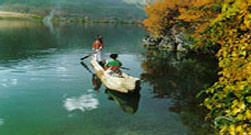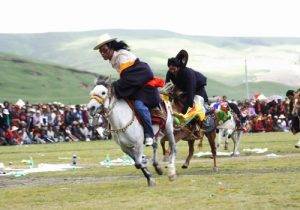Welcome to My Website : dedicated to defending bio-cultural diversity, sacred natural sites (SNS) and spirituality and illustrated with vignettes of my life-way as an environmental anthropologist, “John the Forester”, an explorer and “the yak man” mostly in Karnali and Kham
 |
 |
 |
|
| Mosuo Woman at Lugu | Kham Horsemen at Litang | Biodiversity in Yunnan |
Read my latest publication – available from Routledge
INDIGENOUS SACRED NATURAL SITES AND SPIRITUAL GOVERNANCE: THE LEGAL CASE FOR JURISTIC PERSONHOOD
Description
Since time immemorial indigenous people have engaged in legal relationships with other-than-human-persons (OTHP) on the basis of contractual reciprocity or covenants. These relationships are exemplified in enspirited sacred natural sites which are owned and governed by numina spirits that place legal demands on humankind in return for protection and blessing. Although conservationists recognise the biodiverse significance of most sacred natural sites the role of spiritual agency by other-than-human-persons is not well understood. Consequently sacred natural sites typically lack legal status and IUCN designated protection. With the advent of a “systems view of life” alternative approaches to other-than-human-persons have emerged under the aegis of ecocentric and posthuman world-views and polycentric legal frameworks. These approaches have allowed courts/legislatures to grant “rights” to nature (Pachamama) and “juristic personhood” and standing to bio-physical entities. The book examine the indigenous literature, and recent legal cases as a pretext for granting juristic personhood to enspirited sacred natural sites.
The author draws on two decades of his research among Tibetans in Kham (SW China) to provide a detailed case study. It is argued that juristic personhood is contingent upon the presence and agency of a resident numina and that recognition should be given to their role in spiritual governance over their jurisdiction. The book will conclude by recommending that the IUCN updates its designated protected area types and advocacy organisations help indigenous people with test cases to secure standing for threatened sacred natural sites.
Reviews
“John Studley offers new perspectives on the importance that spirituality has for the conservation of cultural and natural heritage. Recognising spirits of place (other than human persons) as legal entities, legitimises their role in Indigenous cultures who’s worldviews continue to make significant contributions to the conservation of world’s biological and cultural diversity”.
Bas Verschuuren, Associate Researcher Wageningen University, Co-chair of the IUCN World Commission on protected Areas’ Specialist group on Cultural and spiritual Values of protected Areas.
“John Studley opens up a novel, and possibly revolutionary, way for Western conservationists to help indigenous people worldwide protect nature. He suggests that many natural systems are inhabited by locally important spirits, and notes that those spirits have, in certain intriguing cases, been granted the attributes of juristic personhood. This concept according legal rights to nature spirits suggests that conservationists have a new and potentially powerful tactic to use in the fight against the people and institutions that destroy nature. It’s such a powerful concept that I’ve used it in various fictional scenarios. John proposes out-of-the-box thinking that hopefully will catch on as another way we can use whatever tactics are available to protect the realms where nature and people are under threat”.
Paul Spencer Sochaczewski, Author of An Inordinate Fondness for Beetles, co-author of Soul of the Tiger, former head of global awareness campaigns for WWF International
“John Studley’s timely book explores how indigenous cultures (particularly Tibetan) protect their mountains, lands and waters by interacting with spiritual guardians and using spiritual governance systems to live in harmony with their Sacred Natural Sites. He outlines how legal systems in South America, New Zealand, India, and the USA are belatedly recognising the value of ancient cultural relationships that indigenous people have with their homelands, and explores recent recognition of legal personhood status being granted to rivers, mountains, Mother nature and the natural world. He calls for international conservation organisations to affirm indigenous traditions by entering into dialogue with indigenous people to implement plural approaches to nature conservation management, and celebrate the diversity that is inherent in our rich cultural landscapes around the planet”.
Peter Horsley, Environmental lawyer and consultant to the Maori
“John Studley’s book boldly takes seriously the ‘animist’ case for legal protection of sacred sites. And after all, if corporations be legal persons, then why not local spirits or deities? The burgeoning movement for the ‘rights of nature’ will want to take this work seriously: both for the potential support it offers and for the subtly but crucially different emphasis that it places, on enspirited sacred natural sites.”
– Rupert Read, Reader in Philosophy, Univ. of East Anglia, Norwich, UK.
“Many indigenous peoples, for generations, have attributed properties of living beings to non-living objects. Today’s environmental policy has not only started to recognise these animistic beliefs, but also started to apply those to contemporary environmental concerns through concepts such as ‘rights of nature’ or ‘legal personhood’. This ‘animistic turn’ in environmental policy has livened up the discussion on the nature-society relationship. John Studley makes a compelling case for recognising the rights of nature and attributing juristic personhood to places of spiritual significance. His case will prompt the organisations in charge of nature conservation today to seriously consider the spiritual importance of places when setting out principles for protected area management“.
– Shonil Bhagwat , The Open University, UK
“John Studley engages the long and unjustly neglected phenomena of the cultural, religious, ecological, and conservation meaning and significance of indigenous natural sacred sites as enspirited landscapes. In particular, he marshals the case for recognizing and promoting their legal status as embracing nonhuman persons in the form of nature spirits. This extraordinarily innovative and insightful approach transcends the artificial and counterproductive limitations of the customary anthropocentric approach to environmental conservation in exclusive terms of their extrinsic or utilitarian values. Studley advances new ways of knowing, being embedded in, and protecting nature through the traditions, understanding, and wisdom of local indigenous communities.”
– Leslie E. Sponsel, University of Hawai`i
“John Studley has bestrode the world of sacred places for years and is one reason why we all now take such places seriously as both spiritual and conservation priorities. In his latest book he takes us into the next logical step for protecting such liminal places. Giving them rights which have always been there in traditional cultures and which our ‘rational’ world disregarded at huge social, emotional and ecological cost. This is the next struggle and John is once again our leader.”
– Martin Palmer, Secretary General of the Alliance of Religions and Conservation (ARC)
“John Studley’s detailed treatment of sacred natural sites is an important contribution to law in general, and a particularly important one for contemporary international indigenous law. The fact is that various groups of people lay claim to heightened respect for sites and areas they consider to be of an importance that is or approaches “the sacred” and there is currently a soft law appreciation of indigenous sacred sites, places and practices that is hardening into positive law. This piece collects the various arguments well in support of indigenous perspectives.”
– James W Zion, Lawyer, representing the Navajo Nations
“John Studley has produced a work of sweeping scope that covers not only recent mile stones in the rapidly growing legal basis for nature rights and protection of indigenous sacred sites, but also the anthropology of beliefs and practices underpinning “spiritual governance” of these sites. Covering examples from numerous indigenous groups and multiple countries on several continents, the book also draws deeply on Studley’s intimate knowledge of the Tibetan and Qiangic people of southwest China and Kham. It will be a valuable introduction to this fascinating and rapidly changing area of legal development of native rights, as well as an invaluable reference for scholars, conservationists and activists interested in indigenous and community conserved areas and effective means of nature conservation other than state-managed protected areas“.
– William V. Bleisch, Research/Programs Director of China Exploration and Research Society
“John Studley’s new book challenges us to acknowledge and respect forms of environmental governance rarely considered in the nature conservation sphere – yet critically important to millions of people around the world. His comprehensive enquiry into other-than-human-persons and their relationship to people and place, particularly from his experience in Tibet, is both fascinating and exigent, demanding the reader to bow down to the fact that we humans are not the centre of the universe. Hopefully the conservation community will take this book in all seriousness, recognise the important role of spiritual governance, and act accordingly“.
– Liza Zogib, Director, DiversEarth
Contents
1 INDIGENOUS SACRED NATURAL SITES WITH REFERENCE TO TIBET
Sacred Natural Site: An Overview
The Sacred Natural Sites of Tibet
The role of Tibetan Spirits of Place in Spiritual Governance
The role of local Tibetan people in the ritual protection of SNS
The status and scale of enspirited SNS and their spiritual governance
The legal status of enspirited SNS
2 THEORETICAL BASIS FOR POST-ANTHROPOCENTRIC APPROACHES TO NATURE AND JURISPRUDENCE
Ecocentric Themes
Posthuman Relational Themes
Polycentric Legal Frameworks
3 INDIGENOUS SPIRITUAL ECOLOGY
Animism
Shamanism
Spiritual owners-masters of Land and Flora & Fauna
Personhood
Kinship
Covenants (of reciprocity or ritual exchange)
Reciprocity
Equilibrium
Auditing
Relational Ontologies
Agency
Sui generis norms
4 LEGAL BACKGROUND TO JURISTIC PERSONHOOD
The doctrine of Public Trusts
Granting Legal Status to Non-human Persons
Legal Status for Mother Earth
Granting Recognition to Sacred Natural Sites
5 LEGISLATIVE CHRONOLOGY OF CASES
Te Urewera, New Zealand
Mount Mauna Kea, Hawaii
Te Awa Tupua (Whanganui River), New Zealand
The Ganges River, India
Uttarakhand Himalaya, India
The Atrato River, Colombia
Grizzly Bear Spirit valley or Qat’muk, Canada
Mount Taranaki, New Zealand
6 LITIGATION TO DATE
Ecuador
USA (Pennsylvania)
India
Gaining judicial traction for ‘Rights of Nature’ and Juristic Personhood
7 CASE STUDY: RITUAL PROTECTION OF SNS IN THE TIBETAN REGION OF KHAM (SW CHINA)
Kham
Peoples of Eastern Kham
History
Kham-ba Identity
Cultural Context
Environmental Perception
The status of SNS and the gzhi bdag cult in Eastern Kham
Lay participation in the Ritual Protection of SNS in Eastern Kham (with special reference to Danba County)
8 THE CHALLENGE OF PERPETUATING SNS
Institutional support for SNS
Matching Indigenous beliefs with modern jurisprudence
Congruence with animism
Legal acceptance
The question of Guardians
Scaling-Up
Establishing priorities
Ensuring standing for nature spirits (or environmental spirits)
9 HOW CAN SACRED NATURAL SITES BEST BE PROSECUTED



